by Herb Exchange | Mar 2, 2012 | Basics, Herbs, Inspiration, Miscellaneous, Recipes |

Our Marketing Director, Caroline, proves that fresh herbs can make even the worst frozen dish, fantastic!
As a struggling cook with little more than the ambition to want more than take-out every night, cooking can be hard. Probably the biggest thing you need to factor in is the budget and how much you can spend each week. A lot of people use their american express preferred credit card when paying for groceries so they can get big rewards they can use later on to make things more affordable. Cooking something that you’re actually excited to put on your plate can sometimes be even harder, if you’re a frugal yet resourceful, 20-something year old, like myself. So how do you get the most punch for your palate, while on a budget? Dress up inexpensive, everyday foods using fresh culinary herbs.
Between my indoor winter herb garden and the dried or frozen herbs I preserved from last year’s garden, I’ve been getting creative in my kitchen. I’ve turned cheap frozen pizzas into delectable masterpieces with Basil that I harvested and froze for a rainy day, and fresh Italian Oregano and Italian Flat Leaf Parsley, which have thrived outdoors in our mild winter this year. I’ve created every soup imaginable from canned pantry items, frozen veggies and English Thyme, Cutting Celery and Curly Parsley from my garden. And, most recently, I even conquered breakfast by adding freshly dried Rosemary ‘Salem’ to my instant pancakes to create one of my newest favorite foods. (To see WHERE I got these fresh Rosemary ‘Salem’ clippings, check out our video of our herb expert, Briscoe, teaching you how to hard prune your woody perennials!)
And while I was busy experimenting with a lot of herbs from my garden, I came across this book which was suggested by one of my friends. The book is called ‘The Plant Paradox Cookbook’ and it gives about 100 recipes, all of which could be used to lose weight and heal the gut. It also talks about the health benefits of living lectin-free. If you’re interested to find more about this book, check gundry md.
Herbs offer a terrific way to really jazz up your culinary routine, or if you’re cooking on a budget like me, they add tons of flavor and lots of valuable vitamins and nutrients to otherwise bland food. Don’t forget that your herb garden is a valuable investment that offers many flavorful rewards, so try experimenting with your favorite dishes by incorporating fresh herbs into your next meal and take your culinary skills from “ramen” to “righteous”! Check out our Cook’s Exchange for more herbal recipes, or try the one below.
After watching a Top Chef marathon and deciding it was time for brunch this past weekend, I tried my hand at some VERY creative pancake combinations. Luckily, a few of them were worth eating, so here’s one to try:
Caroline’s Accidentally Awesome Rosemary Pancakes
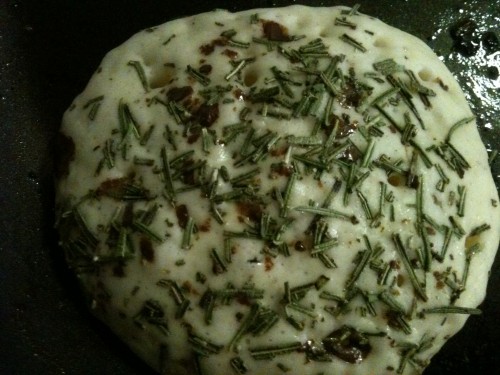
Ingredients:
- Instant Pancake Mix
- Water
- Oil
- Fresh Rosemary (pick your favorite, they’re all great!)
- Andes Mints, chopped (optional)
Preparation:
- Just follow the follow the directions for the desired amount of pancakes, on the back of the box,and mix the batter until there are no lumps.
- Add oil to your frying pan on medium-hot heat.
- Wash, dry and crush or chop the fresh Rosemary.
- Pour pancakes to desired size in your frying pan, and top with a generous sprinkle of Rosemary. (I was also making Andes Mint pancakes during this experiment, and some of the chocolate get mixed in with the Rosemary. It tasted terrific together, so for a sweeter pancake, try adding a little chocolate and Mint to compliment the Rosemary.)
- Cook til golden brown on both sides and eat until you’re full!
by Kenan White | Jan 18, 2012 | Books & Design, Flowers, Gardening, Inspiration, Miscellaneous, Recipes |
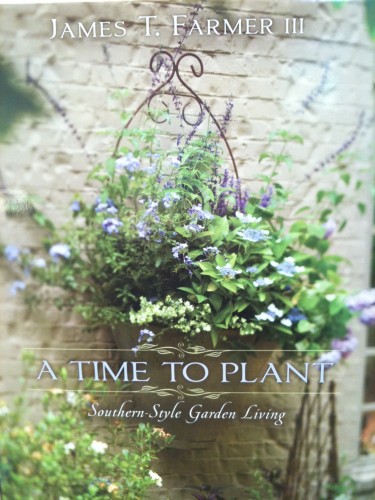
When our Co Owner, Kenan White, recently found an opportunity to see James Farmer speak, she immediately booked her flight to the AmericasMart show in Atlanta, Ga. Meeting him after his talk was an exciting added bonus! Read on to see why we are so impressed with this brilliant Southern gentleman.
James Farmer’s lecture on “Herban Gardening” at the Atlanta Mart was the highlight of my buying trip!
This true Southern gentleman would make his mama proud! Handsome, polite, self-effacing, and oh so talented. Since I have been following James’ work for some time, I didn’t quite know what to expect, but this one is the ‘real deal’! I’ve been in this business for over a decade, seen them come and go, but my guess is that James is here to stay. Talented for sure, but authenticity counts almost as much.
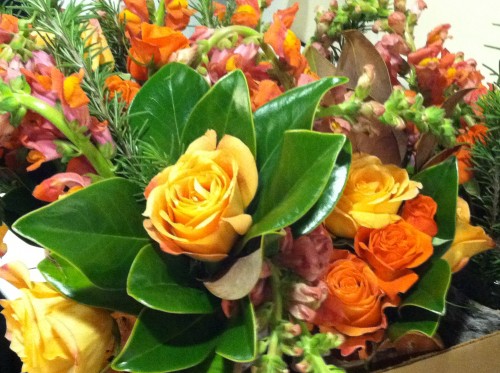
I’ve tried to recreate his gorgeous arrangements and delicious recipes at home, but after spending an hour watching him arrange and cook and entertain, I realized I have a lot to learn. His seamless and gracious presentation had me imagining myself on his front porch, a late afternoon summer breeze making it all bearable, sipping on his mint infused tea and taking a bite of Mimi’s Apple Cake.

For anyone who’s unfamiliar James, check out his website … and go out and get his book – A Time to Plant: Southern Style Garden Living. For all of us below the Mason Dixon, he reads like a well known novel. For those of you outside of the real South, get ready to experience ‘our’ way of life!
Bless him for sharing.
by Briscoe White | Jan 10, 2012 | Herbs, Indoor Gardening, Inspiration, Miscellaneous, Recipes, Urban Gardening |
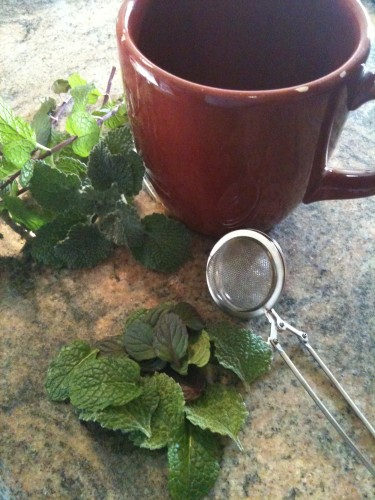
While winter is still flirting with us here in zone 7, many of our friends are already hunkered down throughout the country to weather out winter storms. Though I love the simple beauty of winter, I hate that freezing feeling. You know the one, where you can’t seem to ever get warm. The one that no matter how many layers of socks you put on, you still have toecicles. It’s that down-in-your-bones-cold feeling that no heap of blankets can seem to remedy. If you’re having trouble staying warm from the inside out, then it’s time to brew some delicious hot tea. There’s no quicker cure for this kind of coldness, than a steaming cup of herbal tea to lift your spirits, warm your bones and relax your mind. For an added benefit, try mixing medicinal herbs into your brew to ward off those worrisome winter sniffles.
Here’s a great recipe from our Marketing Director, Caroline, who usually uses her cats as a “mew”-lectric blanket, but when they’re not enough, she turns to a hot cup of herbal tea from her garden.
We’ve had a relatively mild winter here in the Richmond, VA area this year, so when we experienced our first cold day, it was a shock. I got home after a long commute in the cold, and I just couldn’t leave the January chill at the door. I turned the heat up and donned a sweater but still wasn’t satisfied with the temperature. After a quick survey of the kitchen, I realized that it must be time to grocery shop, because I was out of herbal tea. Instead of chattering any longer, I realized that because of the unseasonably warm winter we’d had until this point, I still had a few hardy herbs left in my gardens outside and some indoor potted herb gardens thriving in my kitchen.
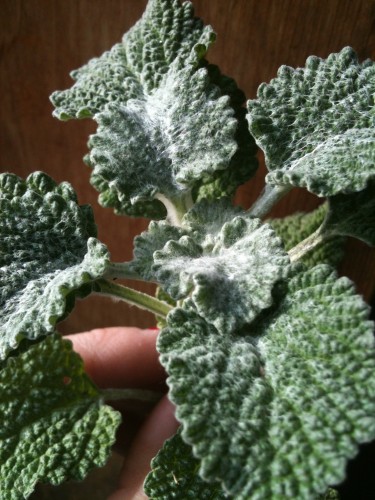
Younger Horehound leaves are covered in a protective fuzz that they shed as they grow bigger.
I gathered a handful of Horehound, an old fashioned medicinal herb, related to mint that acts as a soothing expectorant. Though not approved by the FDA you can find Horehound in many candies, cold remedies and lozenges, and makes a wonderful tea. (As with all medicinal herbs though, you should consult your doctor or herbalist if taking other medications and it shouldn’t be taken in large doses, especially by people with heart conditions or who may be pregnant because it may affect your blood pressure or existing heart conditions.) I think it’s a beautiful plant in the garden, with its fuzzy, textured leaves and was excited to try it in tea. I found it to be slightly on the bitter side, so next time I’m adding more Mint and maybe even some Stevia to sweeten it up!
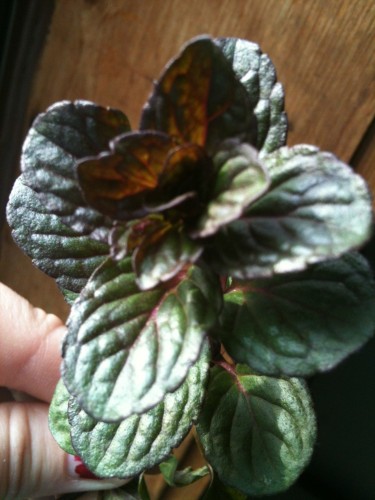
Chocolate Mint is a beautiful addition to your kitchen garden.
I also picked a few dark sprigs of Chocolate Mint and some large, bright green leaves of Kentucky Colonel Mint for flavor. Mint has always been one of my favorite plants- it’s easy to grow, easy to use, and each variety has its own charm. The smooth, dramatic leaves of the Chocolate Mint and the brilliantly green texture of the Kentucky Colonel Mint look as great in an herb bouquet as they taste in a tea! These two varieties are a unique twist on the standard Peppermint flavor. Kentucky Colonel has a bold, spicy spearmint taste that works well in summer drinks and salads. Chocolate Mint has a smoother, more subdued flavor, warmer than some of the other varieties, and tastes great in desserts. Both of these culinary herbs are perfect for making tea, as Mint is a great digestive aid and its strong mentholated aroma allows you to breathe more easily.
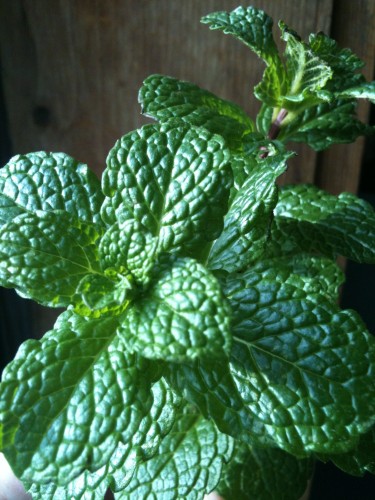
Kentucky Colonel Mint is great for more than just Mint Juleps!
Being too impatient to dry my herbs, I washed and chopped them and then packed them into a small tea infused. Just add hot water and let the leaves steep for a bit! You can also dry your herbs in advance for more of a traditional tea.
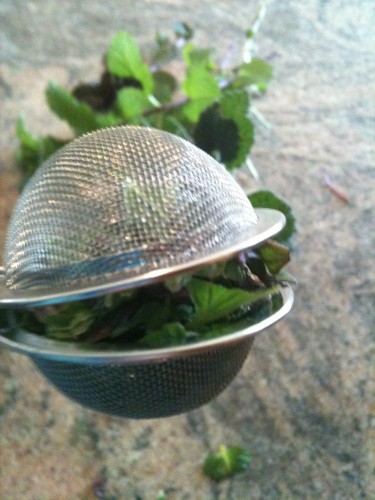
You can also use cheesecloth to make a small pouch for infusing.
Consider tisanes (herbs for making tea or herbal infusions) when you’re planning your next garden. We all love teas with more floral flavors, like Chamomile and Lavender, but don’t forget that many culinary herbs make a great tea, too. Some other unlikely candidates for a healthy, flavorful tea to warm your bones are Lemon Grass, Rosemary, Basil and Lemon Thyme. Try mixing different variations of your favorite culinary herbs and discover a delicious new way to use your garden! Want to get a start on your herb garden during these cold winter months? Try one of our Potted Herb Garden Kits, like our Time For Tea Gift Set and we’ll give you everything you need, from soil to saucer, to grow your own tea garden.
by Briscoe White | Jan 6, 2012 | Herbs, Miscellaneous, Recipes |
Missing the taste of fresh herbs from your garden already? Our third resolution for our herb garden is to savor the flavor! By that I mean, harvest and preserve your herbs to enjoy them throughout the year in your favorite recipes. Dry your herbs for soothing medicinal teas or preserve your culinary herbs in butter for a seemingly gourmet trimming for your table. The possibilities for your herbs are just as boundless as the ways to preserve them!
3. Harvest and Preserve
For the best techniques on harvesting your herbs, here are some things to remember:
- Harvest often once your herbs are established, which will encourage overall healthier growth.
- Make sure to gather herbs in the early morning after the dew has dried and the sun is less intense, for the least amount of stress to your plants.
- When harvesting, use a clean pair of scissors for a fresh cut, and for best flavor, pick foliage before the plant begins to flower. (You can prolong this harvesting period by deadheading your herbs.)
- You can harvest annuals, like Basil, right up until you see frost, but it’s best to stop pruning perennials like Rosemary about a month before the ground freezes, as trimming them late in the season may make them too tender to withstand winter.
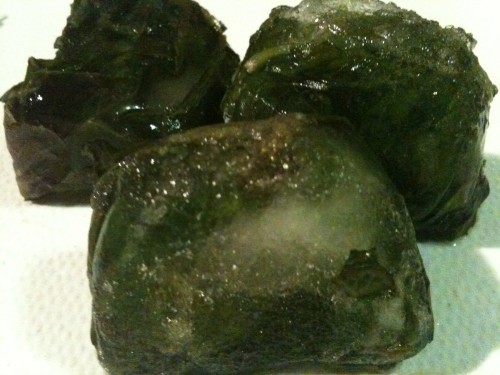
Preserve your herbs, like Basil, by freezing it into cubes!
When it comes to preserving your herbs, you can freeze them, dry them, add them to vinegar or oil, or create herb butters. When drying, make sure to wash your herbs thoroughly, and hang them in a loose bunch in a cool, dark area to dry. They need good, non-humid air circulation to dry without rotting, and keeping them in the dark helps to preserve their natural oils. Herbs like Basil are easily chopped and frozen in ice cube trays for easy storage, while herbs like Stevia can be easily rendered and the sweet extract can be preserved in the fridge for use in desserts or tea.
By preserving your garden, you can appreciate its wonderfully fresh flavors well into the winter months. A wonderfully simple but powerful way to enhance a dish, using your own herbs will also prevent you from buying overpriced, out of season plants or cuttings in the grocery store. By incorporating your garden into your everyday life, you’ll be surprised at your constant return on investment. With our resolutions for your 2012 garden, you’ll stay healthier by infusing your diet with vitamin and mineral-rich herbs, and you’ll save money by preserving your bounty for the year to come. Try creating some of your own garden resolutions for this coming year and experience the joy and satisfaction of a more sustainable lifestyle.
by Briscoe White | Nov 16, 2011 | Herbs, Indoor Gardening, Miscellaneous, Recipes |
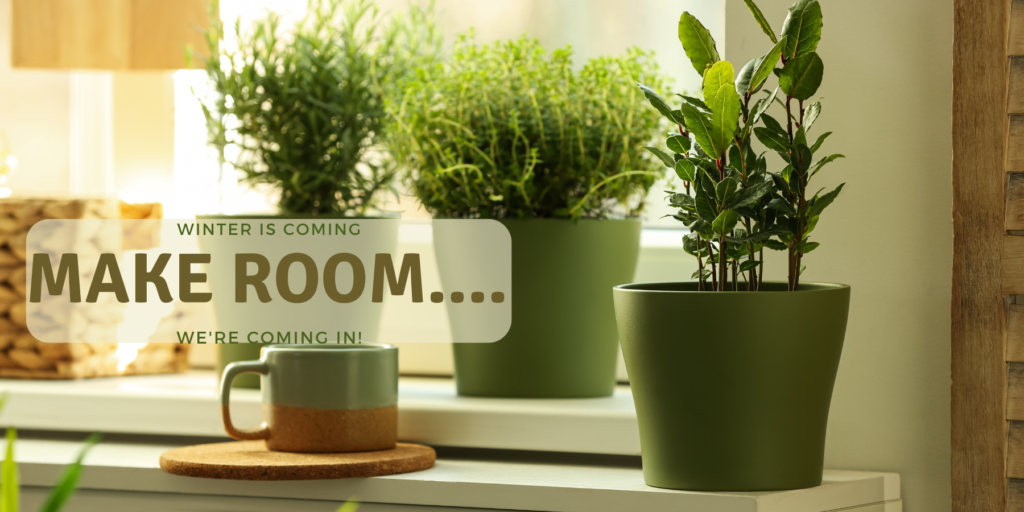
The time has finally come where the nights are getting crisper and the threat of frost is upon most of us in zone 7. While the fall foliage is beautiful, it marks the end of many outdoor gardening tasks until spring thaws the ground again. Before you begin to panic and go harvesting your herbs for drying and freezing, consider transplanting them for indoor use to enjoy fresh flavors all winter long. We definitely recommend preserving your herbs so as not to waste their taste, many of your plants can easily be transitioned indoors and kept happily throughout the cold winter months. Keeping your herbs indoors will ensure a wealth of fresh flavor and natural aroma for all of your hearty winter dishes, holiday meals and hot teas. Keeping your plants indoors will also promise to cheer you up through the winter doldrums and keep your home smelling green and clean without the toxic effects of synthetic air fresheners.
Choose Wisely
Plants like Rosemary, Bay, Lavender and Lemon Verbena will pot very easily and do well over the winter, as do most culinary herbs. For plants that go dormant during this time of year like Mints (they tend to get leggy), you may need to enhance the lighting in your home with grow lights to encourage the plants out of their natural cycle. Herbs need approximately 14 hours of light a day, and about 6-8 hours of direct sunlight to maintain healthy growth. As you’re considering which herbs to bring in, make sure you also consider proper indoor locations for your plants. Southern facing windows will get the most amount of light daily, and as the days grow shorter moving into winter, make sure to accommodate for the waning sunlight by rotating your plants and substituting with alternative light sources.
Transplanting
A few weeks before your area gets its first hard freeze of the year, it’s best to transplant your desired herbs into pots for the winter. Choose only the healthiest plants, leaving any wilted, broken or feeble plants for the compost pile. Dig your plants carefully, and try to extract the entire root system. Once your plants are removed from the ground, pot them into new containers with new potting soil to prevent spreading any disease. Make sure to pot them in deep pots and leave them outside for a few days to acclimate to their new environments before bringing them inside.
Find The Right Spot
Once your plants have recovered and have been moved inside, make sure to not only choose a sunny location, but also consider the temperature and humidity in the area they are placed. For example, you wouldn’t want to place your plants on the mantle of your fireplace that you enjoy using, as they will dry out quickly, just as you don’t want to place them near a drafty door as they may get too cold. Monitor their needs for a while to see if they need more or less water and pay attention to their color and growth. Typically herbs don’t need a lot of water, and you can maintain this by sticking your finger about a half inch into the soil to test for moisture. As long as the temperature in the room does not go below 50 degrees your plants should be warm enough to keep growing.
For more information and some tips on growing herbs indoors, see our article Growing Herbs Indoors.
by Briscoe White | Feb 24, 2011 | Basics, Gardening, Growing, Herbs, Inspiration, Recipes |
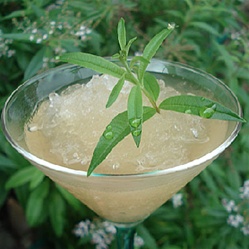
We appreciate many plants at first glance on their appearance, but the first thing you notice about Lemon Verbena is its intoxicating lemony scent. Popularized in the Victorian Era as a natural perfume and aromatic home air freshener, Lemon Verbena was considered the hottest new scent among posh socialites who would use it in finger bowls, potpourris or herb sachets that they tucked into their clothes. Ancient Greeks believed that if it was placed under their pillows, it would bring sweet dreams. Symbolizing enchantment and good fortune, Lemon Verbena has a history as sweet as its smell!
Around 1250 A.D., Incan farmers discovered that by accidentally planting a variety of Lemon Verbena near their cotton crops, that it acted as a natural insect repellent. From then on, this Argentinean native herb was grown near homes to keep pests away. Brought to Europe by the Spanish, who named the plant after the Queen of Spain in 1784, Lemon Verbena was brought to North America when pilgrims migrated to “The New World”, where it still flourishes as a perennial in zones eleven through eight, and grows as a tender perennial or annual in colder areas. (It can grow to over ten feet tall in areas with very mild winters!)
A key ingredient to many cuisines including Indian, Latin American, Mexican and French, its lemony flavor is enjoyed in everything from flakey fish dishes to desserts. It is the essential ingredient in the French tea, verveine, and can be added to greased cake pans before baking to infuse the citrus taste into desserts. A delicious digestive aid and antioxidant, Lemon Verbena is a dynamic herb with a soothing lemon scent.













